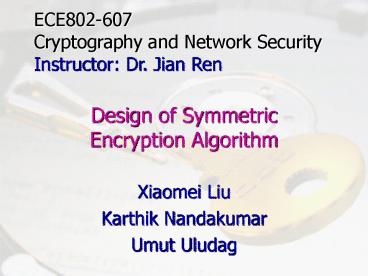Design of Symmetric Encryption Algorithm - PowerPoint PPT Presentation
1 / 15
Title:
Design of Symmetric Encryption Algorithm
Description:
Use the round sub-key to index one of them. Compute inverse based on that polynomial ... the output bits j' and k' should change independently, for all i, j, and k. ... – PowerPoint PPT presentation
Number of Views:75
Avg rating:3.0/5.0
Title: Design of Symmetric Encryption Algorithm
1
Design of Symmetric Encryption Algorithm
ECE802-607Cryptography and Network
SecurityInstructor Dr. Jian Ren
- Xiaomei Liu
- Karthik Nandakumar
- Umut Uludag
2
Roadmap
- Major Features
- Specifications
- Round Transformation
- Key Schedule
- Performance Analysis
- Security
- Time-complexity
- Summary
3
Major Features
- Combines the properties of the simple Feistel
structure used in DES and the finite field
operations of AES - A transformation function F is applied to both
the left and right branches of the Feistel
Structure - Balanced processing allows efficient parallel
implementation - Key-dependent S-boxes for byte substitution
- Based on finite field theory
- Complex sub-key generation algorithm compared to
DES
4
Specifications
- Block Size 64 bits
- Key Length 128, 192, or 256 bits
- Number of rounds 16, 24, or 32
- Sub-key Size 64 bits
- IP and IP-1 were randomly selected
- Number of S-boxes 16
- Size of each S-box 16 16
5
Encryption and Decryption Structure
General Encryption Structure
General Decryption Structure
6
The Round Transformation
Round Decryption
Round Encryption
7
Key Schedule Algorithm
8
Key Schedule Algorithm (cont.)
Table The key shift schedule based on round
index
9
Byte Substitution
- 16 primitive polynomials in GF(28)
- Use the round sub-key to index one of them
- Compute inverse based on that polynomial
- Compute the affine transformation Y MX L
- X is the inverse of the byte to be substituted
10
Security Analysis
- Confusion
- Making the relationship between the cipher text
and the encryption key as complex as possible - each bit in the encryption key must affect many
bits in the cipher text - achieved by complex, non-linear, and
key-dependent S-box transformations and complex
sub-key generation algorithm - Example
- Plain Text AF84FD6A6D263A37
- Key A084FFFF0851C6A9FF1160BA57476773
- Cipher Text 551B35B8E004C9A6
- Invert the bit 4 in the encryption key
- Plain Text AF84FD6A6D263A37
- Key B084FFFF0851C6A9FF1160BA57476773
- Cipher Text 3E05B74136723550
- Number of bit changes in the cipher text 34
11
Security Analysis
- Diffusion
- Making the statistical properties of the plain
text completely obscure - each bit in the plain text must affect many bits
in the cipher text - achieved by repeated permutations (bit shift, mix
column and addition (exclusive-or) of the left
part of the intermediate state to the right part
followed by the interchange of the left and the
right parts) - Example
- Plain Text 958E5DDFD17247CB
- Key 1AC02A4FF9593816D6033583042C70F4
- Cipher Text 06B2AC82F760D311
- Invert the bit 33 in the plain text
- Plain Text 958E5DDF517247CB
- Key 1AC02A4FF9593816D6033583042C70F4
- Cipher Text 507779D551120AF1
- Number of bit changes in the cipher text 34
12
Security Analysis
- Avalanche Effect
- Strict Avalanche Criterion - a change in bit i
of the plain text or the encryption key, changes
the bit j in the cipher text with probability ½ - Example
- Plain Text1 05AACB5FDC6EAF47
- Plain Text2 85AACB5FDC6EAF47
- Key 9A354FEAC1982544
- DF4A0CE745345A12
13
Bit Independence Criterion
- When a single input bit i is inverted, the
output bits j and k should change
independently, for all i, j, and k. - Example
- Plain Text1 7D43A15290F83074
- Key1 4DC432786F9A8099526251DE63D0188A
- Cipher Text1 C3A7EAB5F4E08A66
- Invert the bit 33 in the plain text
- Plain Text2 7D43A15210F83074
- Key1 4DC432786F9A8099526251DE63D0188A
- CipherText2 A96D49AE9C9E4E23
- Using a different key
- PlainText1 7D43A15290F83074
- Key2 F968CB3AEEFD54F382CC21E08C4A97A9
- CipherText3 A86588614ACA3AED
- PlainText2 7D43A15210F83074
- Key2 F968CB3AEEFD54F382CC21E08C4A97A9
- CipherText4 98D5FD712B27250D
14
Time Complexity Analysis
15
Summary
- We have developed a secure and efficient
symmetric encryption algorithm - Some of the salient features of the design are
- Balanced processing allowing easy parallelization
- Key-dependent S-boxes
- Complex key schedule algorithm
- We have not analyzed in depth some problems like
weak-keys and differential cryptanalysis































